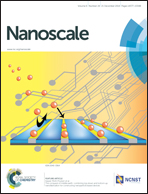Spatially branched hierarchical ZnO nanorod-TiO2 nanotube array heterostructures for versatile photocatalytic and photoelectrocatalytic applications: towards intimate integration of 1D–1D hybrid nanostructures†
Abstract
Hierarchically ordered ZnO nanorods (NRs) decorated nanoporous-layer-covered TiO2 nanotube array (ZnO NRs/NP-TNTAs) nanocomposites have been prepared by an efficient, two-step anodization route combined with an electrochemical deposition strategy, by which monodispersed one-dimensional (1D) ZnO NRs were uniformly grown on the framework of NP-TNTAs. The crystal phases, morphologies, optical properties, photocatalytic as well as photoelectrocatalytic performances of the well-defined ZnO NRs/NP-TNTAs heterostructures were systematically explored to clarify the structure–property correlation. It was found that the ZnO NRs/NP-TNTAs heterostructure exhibits significantly enhanced photocatalytic and photoelectrocatalytic performances, along with favorable photostability toward degradation of organic pollutants under UV light irradiation, as compared to the single component counterparts. The remarkably enhanced photoactivity of ZnO NRs/NP-TNTAs heterostructure is ascribed to the intimate interfacial integration between ZnO NRs and NP-TNTAs substrate imparted by the unique spatially branched hierarchical structure, thereby contributing to the efficient transfer and separation of photogenerated electron–hole charge carriers. Moreover, the specific active species during the photocatalytic process was unambiguously determined and photocatalytic mechanism was tentatively presented. It is anticipated that our work could provide new insights for the construction of various hierarchical 1D–1D hybrid nanocomposites for extensive photocatalytic applications.


 Please wait while we load your content...
Please wait while we load your content...